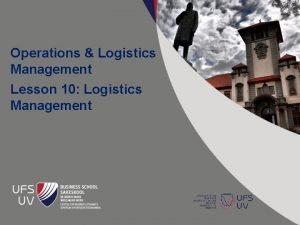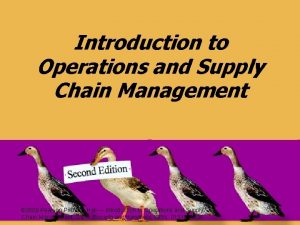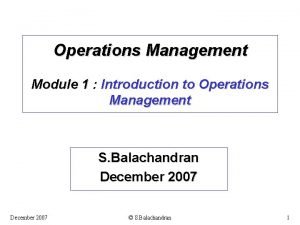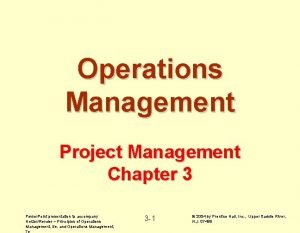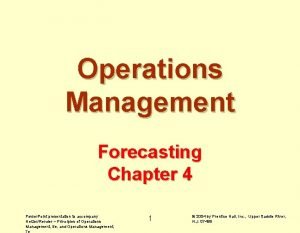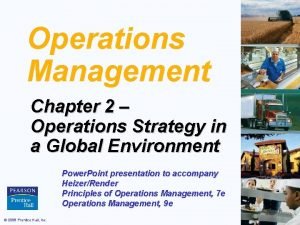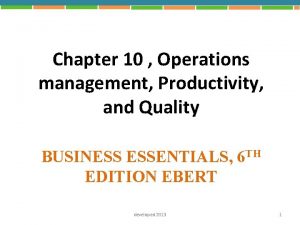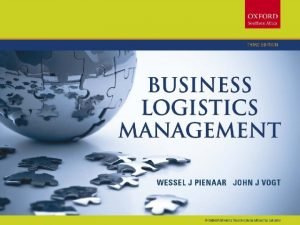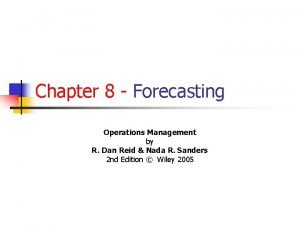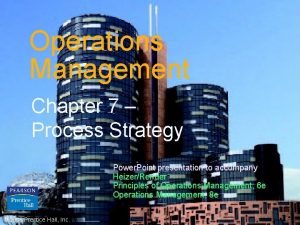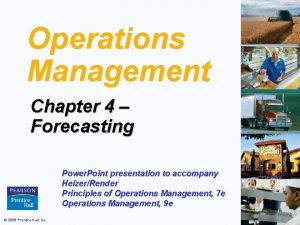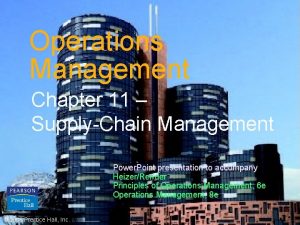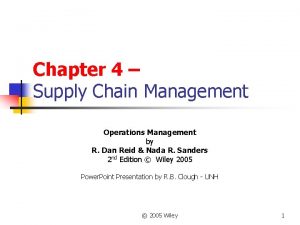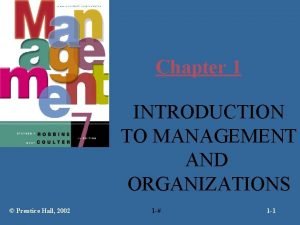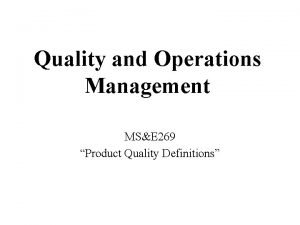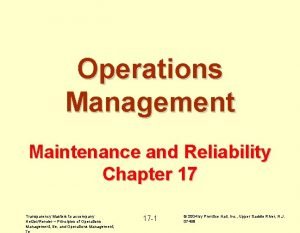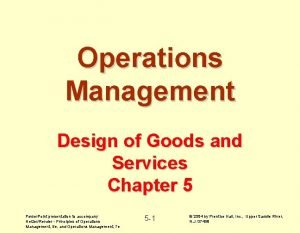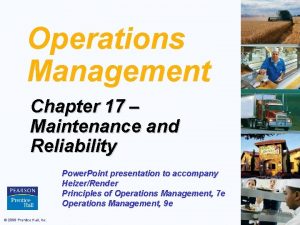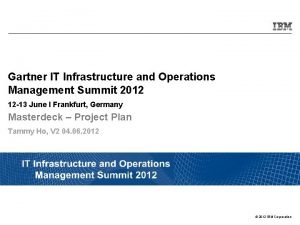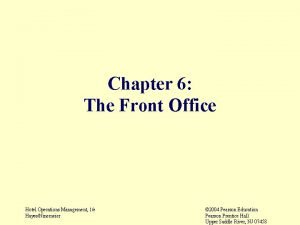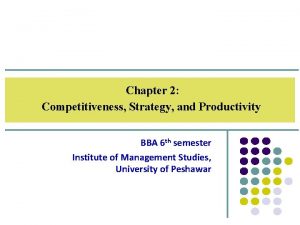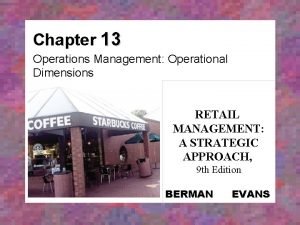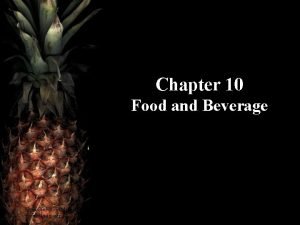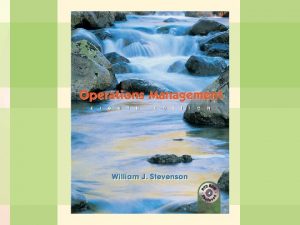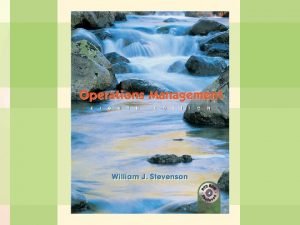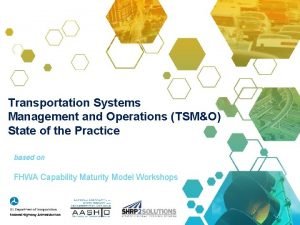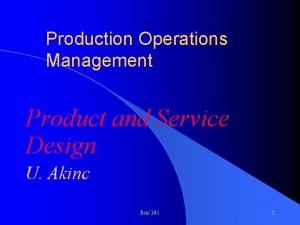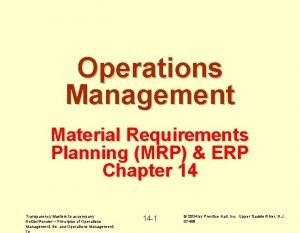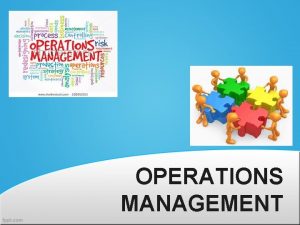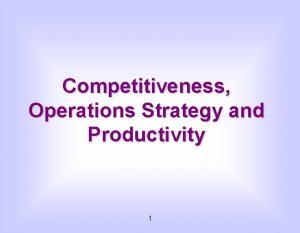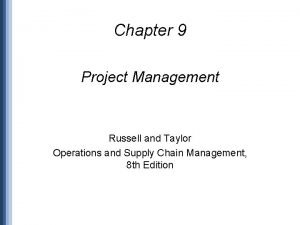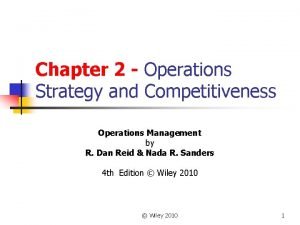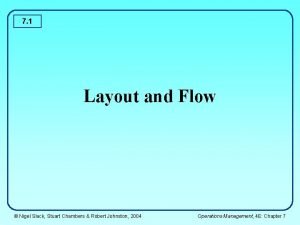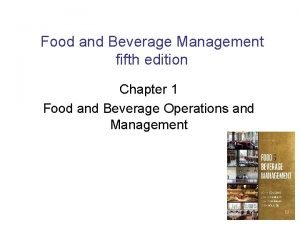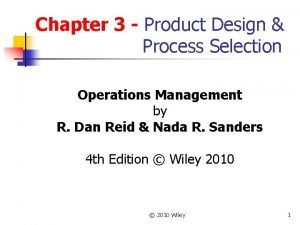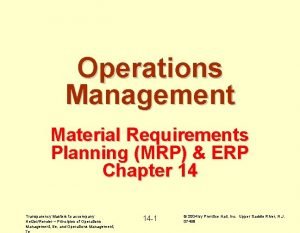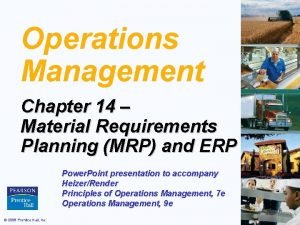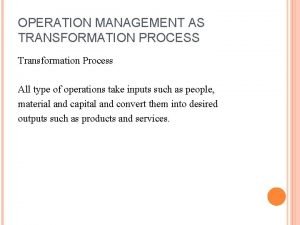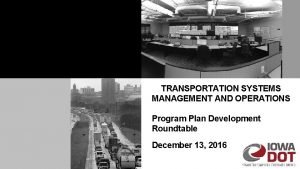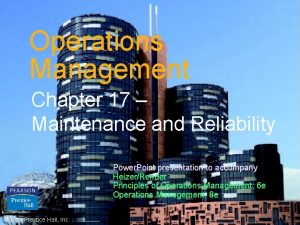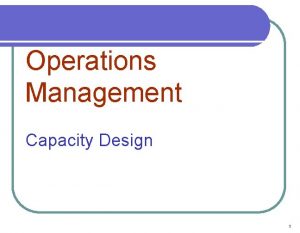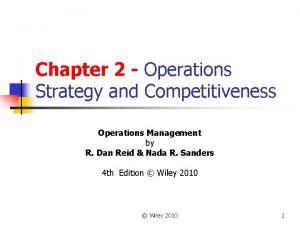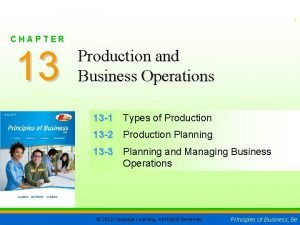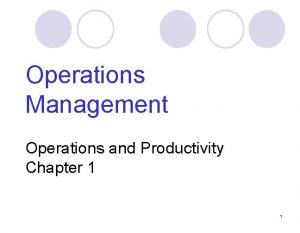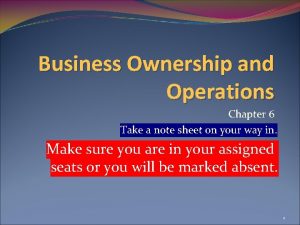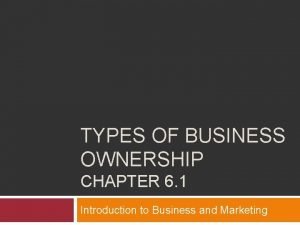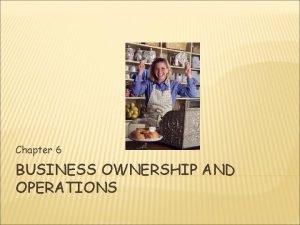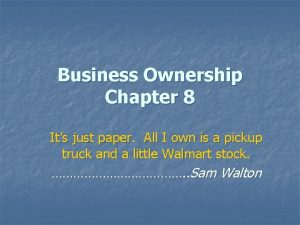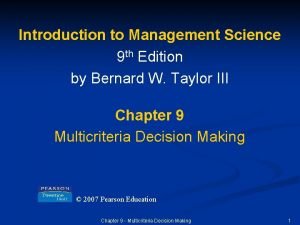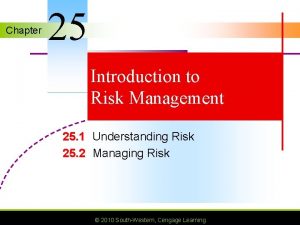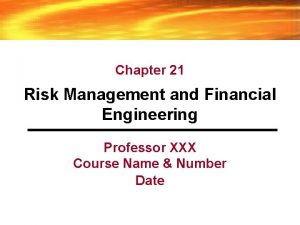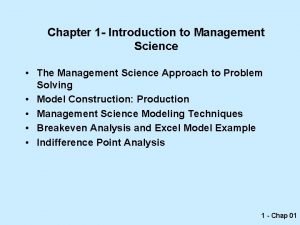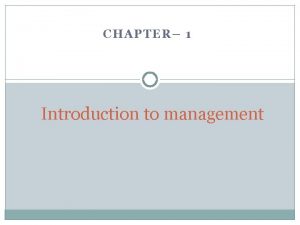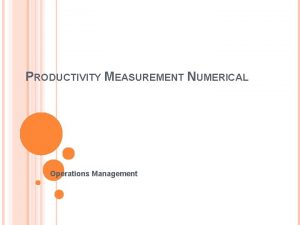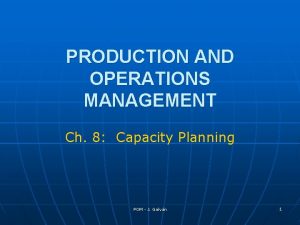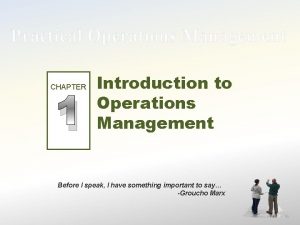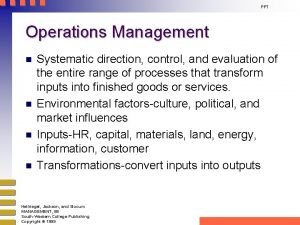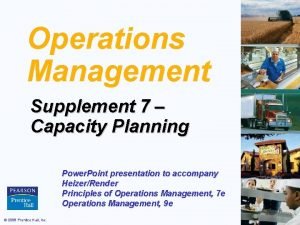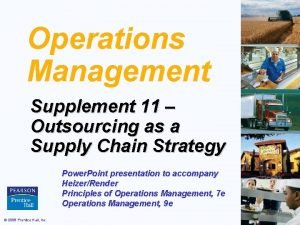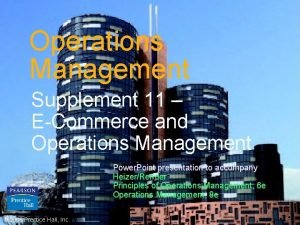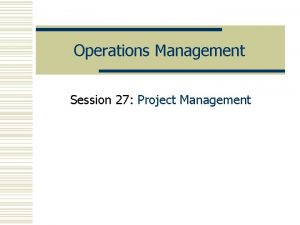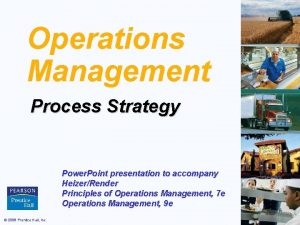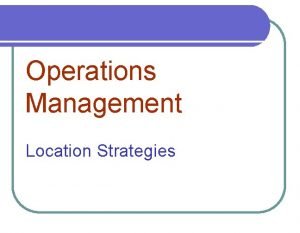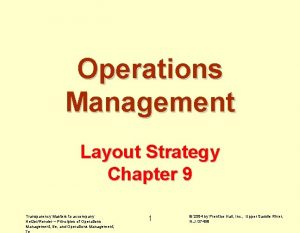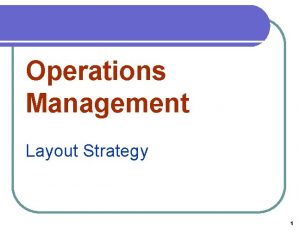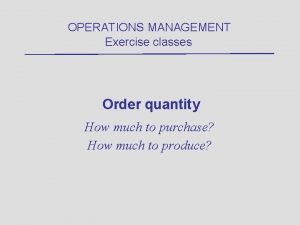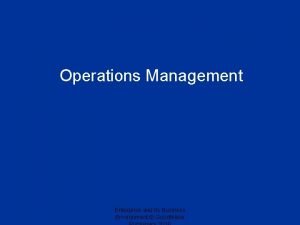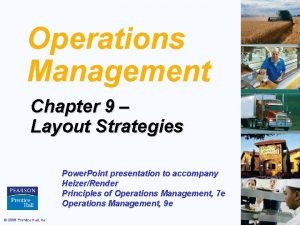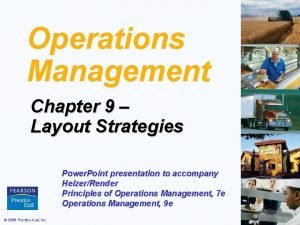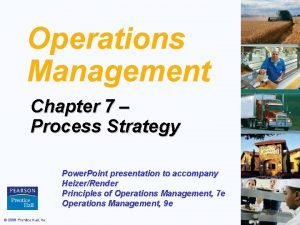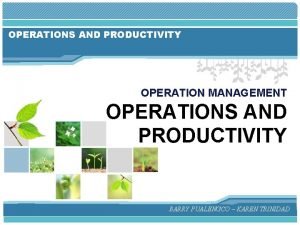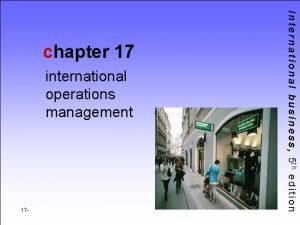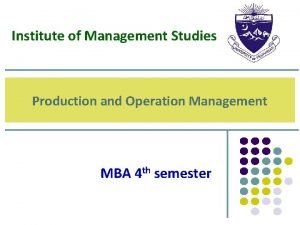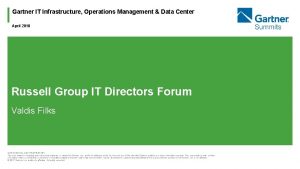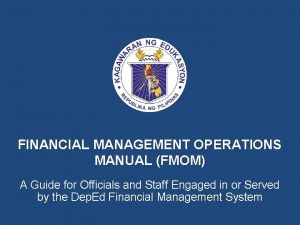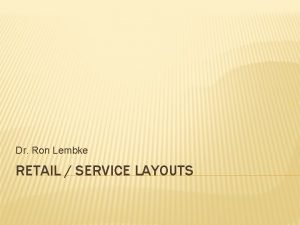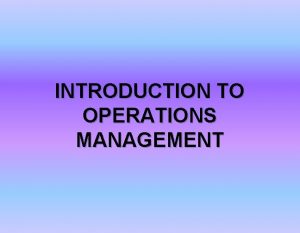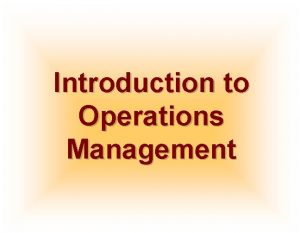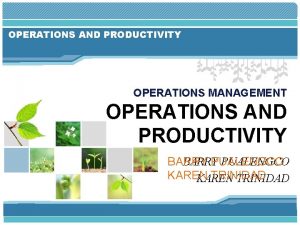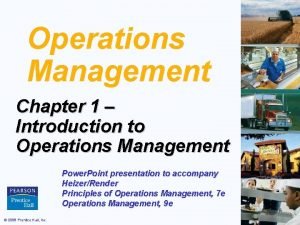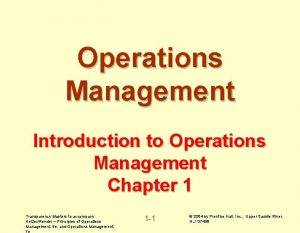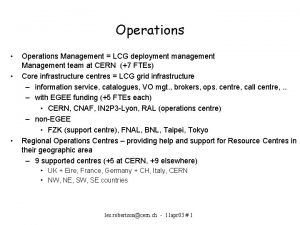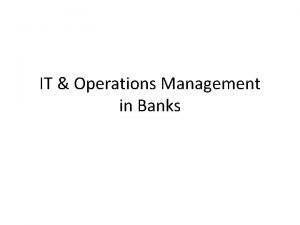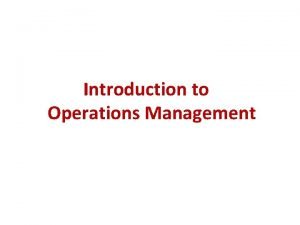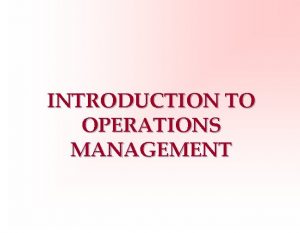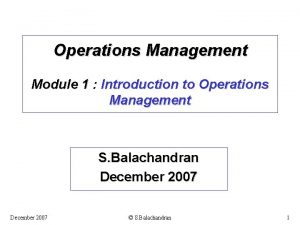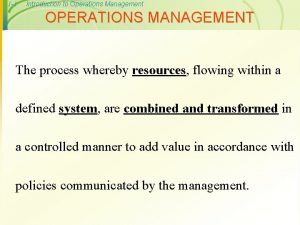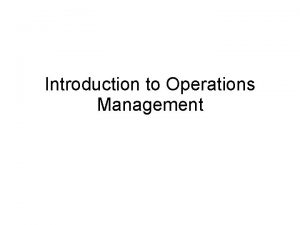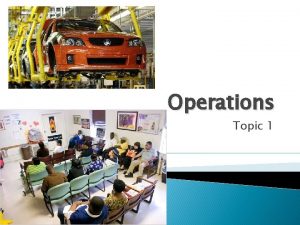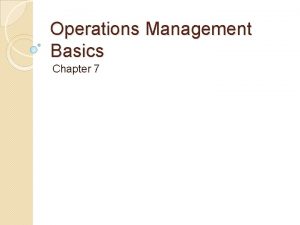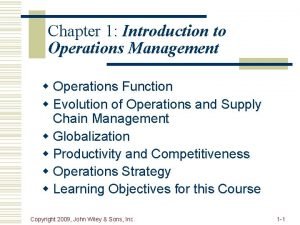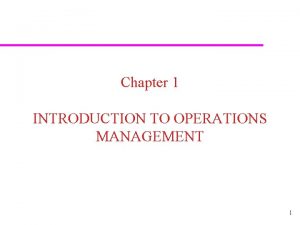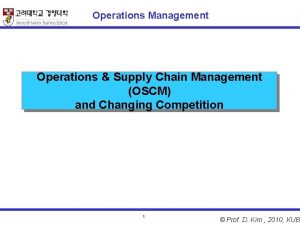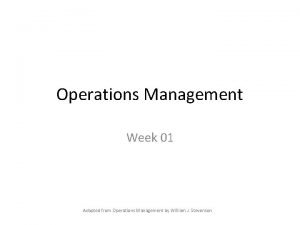Introduction to Operations Management Chapter 1 and 2
































































































- Slides: 96

Introduction to Operations Management Chapter 1 and 2 Operations Management Slack and el Slack, Chambers and Johnston, Operations Management 5 th Edition © Nigel Slack, Stuart Chambers, and Robert Johnston 2007

Operations management defined Operations management is the activity of managing the resources which are devoted to the production and delivery of products and services. Slack, Chambers and Johnston, Operations Management 5 th Edition © Nigel Slack, Stuart Chambers, and Robert Johnston 2007

The consultancy services market – % of world revenues of 40 largest consultancy firms Financial 6 Organizational design 11 Marketing / sales 2 Operations and process management 31 Benefits / actuarial 16 IT strategy 17 Corporate strategy 17 The operations function is fashionable! Slack, Chambers and Johnston, Operations Management 5 th Edition © Nigel Slack, Stuart Chambers, and Robert Johnston 2007

Back office operation in a bank Retail operation Kitchen unit manufacturing operation They are all operations Take-out / restaurant operation Slack, Chambers and Johnston, Operations Management 5 th Edition © Nigel Slack, Stuart Chambers, and Robert Johnston 2007

The best way to start understanding the nature of ‘operations’ is to look around you Everything you can see around you (except the flesh and blood) has been processed by an operation Every service you consumed today (radio station, bus service, lecture, etc. ) has also been produced by an operation Operations Managers create everything you buy, sit on, wear, eat, throw at people, and throw away Slack, Chambers and Johnston, Operations Management 5 th Edition © Nigel Slack, Stuart Chambers, and Robert Johnston 2007

A general model of operations management Transformed resources … The operation’s strategic objectives Operations strategy ØMaterials ØInformation ØCustomers Improvement Design Input resources Transforming resources … The operation’s competitive role and position Operations management Planning and control Output products and services Customers ØFacilities ØStaff Slack, Chambers and Johnston, Operations Management 5 th Edition © Nigel Slack, Stuart Chambers, and Robert Johnston 2007

• Transformed resources – the resources that are treated, transformed or converted in some way – Materials; information and customers • Transforming resources – the resources that act upon the transformed resources – Facilities; staff Slack, Chambers and Johnston, Operations Management 5 th Edition © Nigel Slack, Stuart Chambers, and Robert Johnston 2007

Operations management at IKEA Design elegant products which can be flat-packed efficiently Design a store layout which gives smooth and effective flow Site stores of an appropriate size in the most effective locations Maintain cleanliness and safety of storage area Ensure that the jobs of all staff encourage their contribution to business success Continually examine and improve operations practice Arrange for fast replenishment of products Monitor and enhance quality of service to customers Slack, Chambers and Johnston, Operations Management 5 th Edition © Nigel Slack, Stuart Chambers, and Robert Johnston 2007

Prêt a Manger ‘High-end’ sandwich and snack retailer Uses only ‘wholesome’ ingredients All shops have own kitchens, which make fresh sandwiches every day Fresh ingredients delivered early every morning The same staff who serve you at lunch made the sandwiches that morning “We don’t work nights, we wear jeans, we party …” Slack, Chambers and Johnston, Operations Management 5 th Edition © Nigel Slack, Stuart Chambers, and Robert Johnston 2007

The three basic functions at Prêt a Manger Product / Service Development Promotional activities, market research, etc. Marketing Nutritional ‘mechanical’ and aesthetic design of the sandwiches and snacks Operations Design, location and management of stores and in-store processes and the network that supplies them Slack, Chambers and Johnston, Operations Management 5 th Edition © Nigel Slack, Stuart Chambers, and Robert Johnston 2007

All operations are transformation processes … Inputs Transformation process Outputs that transform inputs … into outputs Slack, Chambers and Johnston, Operations Management 5 th Edition © Nigel Slack, Stuart Chambers, and Robert Johnston 2007

Some inputs are transformed resources Some inputs are transforming resources Transformed resources … ØMaterials ØInformation ØCustomers Input resources Transformation process Output products and services Customers Transforming resources … ØFacilities ØStaff Outputs are products and services that add value for customers Slack, Chambers and Johnston, Operations Management 5 th Edition © Nigel Slack, Stuart Chambers, and Robert Johnston 2007

Transformation Process • Materials processing – Transform physical properties – Change location – parcel delivery – Change possession – retail operations – Storage - warehouse Slack, Chambers and Johnston, Operations Management 5 th Edition © Nigel Slack, Stuart Chambers, and Robert Johnston 2007

• Information Processing – Transform informational properties – Accountants, – Possession of information – libraries; archives – Location of information telecommunications Slack, Chambers and Johnston, Operations Management 5 th Edition © Nigel Slack, Stuart Chambers, and Robert Johnston 2007

• Customer Processing – – Change physical properties – hairdressers – Accommodation – hotels – Psychological state – music, theatre Slack, Chambers and Johnston, Operations Management 5 th Edition © Nigel Slack, Stuart Chambers, and Robert Johnston 2007

Outputs from transformation process • Tangible - goods/intangible -services • Storability – goods storable; services not storable • Transportability – goods can be transported; services – produced simultaneously • Customer contact – low contract – good production; high contact – customer and operation • Quality – goods – judgment based on final product; services – both outcome of service, and the way it was produced. Slack, Chambers and Johnston, Operations Management 5 th Edition © Nigel Slack, Stuart Chambers, and Robert Johnston 2007

Operations can be analyzed at three levels Flow between operations The level of the supply network Flow between processes The level of the operation The level of the process Flow between resources Slack, Chambers and Johnston, Operations Management 5 th Edition © Nigel Slack, Stuart Chambers, and Robert Johnston 2007

Flow between operations Operations management is concerned with the flow of transformed resources between operations, processes and transforming resources, where … Flow between processes External operations interact with internal processes to form the external supply network Flow between resources Processes form an internal ‘supply network’ and become each other’s customers and suppliers Slack, Chambers and Johnston, Operations Management 5 th Edition © Nigel Slack, Stuart Chambers, and Robert Johnston 2007

Three levels of operations management analysis: the supply network, the operation, and the process The supply network – Flow between operations Studios Casting agency Creative agency Promotion agency Broadcasting company The programme and video supply network Programme / video maker The operation – Flow between processes The programme and video operation Slack, Chambers and Johnston, Operations Management 5 th Edition © Nigel Slack, Stuart Chambers, and Robert Johnston 2007

Three levels of operations management analysis: the supply network, the operation, and the process The programme and video supply network Programme / video maker The operation – Flow between processes Engineering Marketing and sales Finance and accounting Production unit Post production The programme and video operation Set and props manufacture The ‘Set and props manufacturing’ process Processes – Flow between resources (people and facilities) Slack, Chambers and Johnston, Operations Management 5 th Edition © Nigel Slack, Stuart Chambers, and Robert Johnston 2007

Three levels of operations management analysis: the supply network, the operation, and the process Programme / video maker The programme and video supply network The programme and video operation Set and props manufacture Set construction The ‘Set and props manufacturing’ process Set design Props acquisition Set finishing Processes – Flow between resources (people and facilities) Slack, Chambers and Johnston, Operations Management 5 th Edition © Nigel Slack, Stuart Chambers, and Robert Johnston 2007

Three levels of operations management analysis: the supply network, the operation, and the process The supply network – Flow between operations Studios Promotion agency Broadcasting Casting company agency Programme / The programme and video supply network video maker Creative agency The operation – Flow between processes Engineering Marketing and sales The ‘Set and props manufacturing’ process Finance and accounting Set and props manufacture Production unit Post production The programme and video operation Set construction Set design Props acquisition Set finishing Processes – Flow between resources (people and facilities) Slack, Chambers and Johnston, Operations Management 5 th Edition © Nigel Slack, Stuart Chambers, and Robert Johnston 2007

Differences within sectors are often greater than the differences between sectors Financial services An account management centre at a large retail bank Financial analyst advising a client at an investment bank Furniture manufacturing Mass production of kitchen units Craft production of reproduction ‘antique’ furniture Hotels Value-for-money hotel Lobby of an international luxury hotel Slack, Chambers and Johnston, Operations Management 5 th Edition © Nigel Slack, Stuart Chambers, and Robert Johnston 2007

A Typology of Operations Low Volume High Variety Low High Variation in demand Low High Visibility Low Slack, Chambers and Johnston, Operations Management 5 th Edition © Nigel Slack, Stuart Chambers, and Robert Johnston 2007

A Typology of Operations Implications Low repetition Each staff member performs more of job Less systemization High unit costs Implications Low Volume High repeatability Specialization Capital intensive Low unit costs Slack, Chambers and Johnston, Operations Management 5 th Edition © Nigel Slack, Stuart Chambers, and Robert Johnston 2007

A Typology of Operations Implications Flexible Complex Match customer needs High unit costs Implications High Variety Low Well defined Routine Standardized Regular Low unit costs Slack, Chambers and Johnston, Operations Management 5 th Edition © Nigel Slack, Stuart Chambers, and Robert Johnston 2007

A Typology of Operations Implications Changing capacity Anticipation Flexibility In touch with demand High unit costs Implications High Variation in demand Low Stable Routine Predictable High utilization Low unit costs Slack, Chambers and Johnston, Operations Management 5 th Edition © Nigel Slack, Stuart Chambers, and Robert Johnston 2007

A Typology of Operations Implications Short waiting tolerance Satisfaction governed by customer perception Customer contact skills needed Received variety is high High unit costs Implications High Visibility Low Time lag between production and consumption Standardization Low contact skills High staff utilization Centralization Low unit costs Slack, Chambers and Johnston, Operations Management 5 th Edition © Nigel Slack, Stuart Chambers, and Robert Johnston 2007

Implications Low repetition Each staff member performs more of job Less systemization High unit costs Flexible Complex Match customer needs High unit costs Changing capacity Anticipation Flexibility In touch with demand High unit costs Short waiting tolerance Satisfaction governed by customer perception Customer contact skills needed Received variety is high High unit costs A Typology of Operations Low High Volume Variety Variation in demand Visibility Implications High repeatability Specialization Capital intensive Low unit costs Low Well defined Routine Standardized Regular Low unit costs Low Stable Routine Predictable High utilization Low unit costs Low Time lag between production and consumption Standardization Low contact skills High staff utilization Centralization Low unit costs Slack, Chambers and Johnston, Operations Management 5 th Edition © Nigel Slack, Stuart Chambers, and Robert Johnston 2007

Examples Generator Factory Gourmet Restaurant Pioneering surgery Tax service University tutorials Corporate tax advice Department store Electricity Utility Financial Audits Emergency service City metro service A Typology of Operations Low High Volume Variety Variation in demand Most health care Dentist Music teacher High Visibility High Low Low Examples Television Factory Fast Food Restaurant Routine Surgery Mass rapid transport University lectures Financial audits Jeans shop Bread bakery Consultancy advice Shopping mall security Trucking operation Most manufacturing Prepackaged sandwich maker Dental Technician Distance learning Slack, Chambers and Johnston, Operations Management 5 th Edition © Nigel Slack, Stuart Chambers, and Robert Johnston 2007

4 V’s profile of two operations Low Volume High Variety Low High Variation Low High Visibility Low Mwagusi Safari Lodge Formule 1 Hotel Important to understand how different operations are positioned on the 4 V’s. Is their position where they want to be? Do they understand the strategic implications? Slack, Chambers and Johnston, Operations Management 5 th Edition © Nigel Slack, Stuart Chambers, and Robert Johnston 2007

• Formula 1 – arranged operations to minimize cost • Island resort hotel – high levels of service but provides them at a high cost Slack, Chambers and Johnston, Operations Management 5 th Edition © Nigel Slack, Stuart Chambers, and Robert Johnston 2007

Some interfunctional relationships between the operations function and other core and support functions Engineering/ technical function Understanding of the capabilities and constraints of the operations process Product/service development function Analysis of new technology options Understanding of process technology needs New product and Accounting service ideas Provision and finance Understanding of the of relevant function capabilities and data Operations constraints of the Financial analysis operations process function for performance Market and decisions requirements Understanding of human resource needs Human resources function Understanding Provision of systems for of infrastructural design, planning and system control, and improvement Recruitment needs development and training Marketing function Information technology (IT) function Slack, Chambers and Johnston, Operations Management 5 th Edition © Nigel Slack, Stuart Chambers, and Robert Johnston 2007

Separate operations processes Function 3 Function 4 Customer needs fulfilled Function 2 Business processes Customer needs Function 1 Conventionally, organizational boundaries are drawn around functional processes Slack, Chambers and Johnston, Operations Management 5 th Edition © Nigel Slack, Stuart Chambers, and Robert Johnston 2007

Separate operations processes Function 3 Function 4 Customer needs fulfilled Function 2 Business processes Customer needs Function 1 BPR advocates reorganizing (reengineering) micro operations to reflect the natural customer-focused business processes Slack, Chambers and Johnston, Operations Management 5 th Edition © Nigel Slack, Stuart Chambers, and Robert Johnston 2007

Marketing and Sales Set and props manufacture Engineering Production units Finance and costing Promotional and advertising contracts Technical support contracts Music videos Example of how each micro operation contributes to the business processes which fulfil external needs Customer needs fulfilled Customer needs Programme production Business processes Preparing quotations Size of each micro operation’s continuation to each process Slack, Chambers and Johnston, Operations Management 5 th Edition © Nigel Slack, Stuart Chambers, and Robert Johnston 2007

The Role of the operations function Slack, Chambers and Johnston, Operations Management 5 th Edition © Nigel Slack, Stuart Chambers, and Robert Johnston 2007

What is the role of the Operations function? Operations as implementer Operations as supporter Operations as driver Operations Strategy Operations implements business strategy Operations supports business strategy Operations drives business strategy Slack, Chambers and Johnston, Operations Management 5 th Edition © Nigel Slack, Stuart Chambers, and Robert Johnston 2007

The strategic role of the Operations function The 3 key attributes of Operations contribution Implementing Be dependable Operationalize strategy Explain practicalities Supporting Be appropriate Understand strategy Contribute to decisions Driving Be innovative Provide foundation of strategy Develop long-term capabilities Slack, Chambers and Johnston, Operations Management 5 th Edition © Nigel Slack, Stuart Chambers, and Robert Johnston 2007

The four-stage model of Operations contribution Increasing strategic impact Redefining industry expectations Holding the organization back o tio Clearly the best in the industry As good as the competitors f no ibu r t on c g in s a e r STAGE 2 Adopt best practice Inc STAGE 1 Correct the worst problems Internally neutral ing t en y m g ple rate Im st Externally neutral ra e p ns tio STAGE 3 Link strategy with operations STAGE 4 Give an operations advantage ng y i v i Dr ateg str g tin r po egy p Su trat s Internally supportive Externally supportive Increasing operations capabilities Slack, Chambers and Johnston, Operations Management 5 th Edition © Nigel Slack, Stuart Chambers, and Robert Johnston 2007

Internal neutrality • Poorest level of contribution • Operation is considered a necessary evil • Inward looking and reactive Slack, Chambers and Johnston, Operations Management 5 th Edition © Nigel Slack, Stuart Chambers, and Robert Johnston 2007

External neutrality • Comparing itself with similar companies or organisations in the outside market • Take the best ideas and norms of performance from the rest of its industry Slack, Chambers and Johnston, Operations Management 5 th Edition © Nigel Slack, Stuart Chambers, and Robert Johnston 2007

Internally supportive • Reached the first division in their market • May not be better than competitors but they are broadly up with the best • Developing appropriate strategies while at the same time they are taking on the role of implementers of strategy Slack, Chambers and Johnston, Operations Management 5 th Edition © Nigel Slack, Stuart Chambers, and Robert Johnston 2007

Externally supportive • Sees the operation function as a foundation for its future competitive success • Looks to the long term • Forecasts likely changes in markets and supply and develops operation based strategies allowing it to compete in future market conditions. Slack, Chambers and Johnston, Operations Management 5 th Edition © Nigel Slack, Stuart Chambers, and Robert Johnston 2007

Broad strategic objectives for an operation applied to stakeholder groups Society Increase employment Enhance community well-being Produce sustainable products Ensure clean environment Suppliers Continue business Develop supplier capability Provide transparent information Shareholders Economic value from investment Ethical value from investment Customers Appropriate product or service specification Consistent quality Fast delivery Dependable delivery Acceptable price Employees Continuous employment Fair pay Good working conditions Personal development Slack, Chambers and Johnston, Operations Management 5 th Edition © Nigel Slack, Stuart Chambers, and Robert Johnston 2007

Quality Being RIGHT Speed Being FAST Dependability Flexibility Cost Being ON TIME Being ABLE TO CHANGE Competitiveness The Operations function can provide a competitive advantage through its performance at the five competitive objectives Being PRODUCTIVE Slack, Chambers and Johnston, Operations Management 5 th Edition © Nigel Slack, Stuart Chambers, and Robert Johnston 2007

What do the terms quality, speed, dependability, flexibility and cost mean in the context of operations? Which enables you to do things cheaply (cost advantage)? Which enables you to change what you do (flexibility advantage)? Which enables you to do things quickly (speed advantage)? Which enables you to do things on time (dependability advantage)? Which enables you to do things right (quality advantage)? Slack, Chambers and Johnston, Operations Management 5 th Edition © Nigel Slack, Stuart Chambers, and Robert Johnston 2007

The benefits of excelling Minimum price, highest value Cost Quick delivery Minimum cost, maximum value Speed Fast throughput Error-free products and services Dependable delivery Quality Dependability Reliable operation Error-free processes Ability to change Flexibility Frequent new products, maximum choice Slack, Chambers and Johnston, Operations Management 5 th Edition © Nigel Slack, Stuart Chambers, and Robert Johnston 2007

What does Quality mean in … … a hospital? Patients receive the most appropriate treatment Treatment is carried out in the correct manner Patients are consulted and kept informed Staff are courteous, friendly and helpful Slack, Chambers and Johnston, Operations Management 5 th Edition © Nigel Slack, Stuart Chambers, and Robert Johnston 2007

What does Quality mean in … … an automobile plant? All assembly is to specification Product is reliable All parts are made to specification The product is attractive and blemish-free Slack, Chambers and Johnston, Operations Management 5 th Edition © Nigel Slack, Stuart Chambers, and Robert Johnston 2007

What does Quality mean in … … a bus company? The buses are clean and tidy The buses are quiet and fume-free The timetable is accurate and user-friendly Staff are courteous, friendly and helpful Slack, Chambers and Johnston, Operations Management 5 th Edition © Nigel Slack, Stuart Chambers, and Robert Johnston 2007

What does Quality mean in … … a supermarket? The store is clean and tidy Décor is appropriate and attractive Goods are in good condition Staff are courteous, friendly and helpful Slack, Chambers and Johnston, Operations Management 5 th Edition © Nigel Slack, Stuart Chambers, and Robert Johnston 2007

Quality ‘Quality’ has several meanings. The two most common are … Quality as the specification of a product or service e. g. Lower Hurst Farm produces organic meat raised exclusively on its own farm Quality as the conformance with which the product or service is produced e. g. Quick-service restaurants like Mc. Donald’s may buy less expensive meat, but its conformance must be high Slack, Chambers and Johnston, Operations Management 5 th Edition © Nigel Slack, Stuart Chambers, and Robert Johnston 2007

Quality Irrespective of a product or service’s specification quality, producing it so it conforms to its specification consistently brings benefits to any operation Externally – it enhances the product or service in the market, or at least avoids customer complaints Internally – it brings other benefits to the operation: It prevents errors slowing down throughput speed It prevents errors causing internal unreliability and low dependability It prevents errors causing wasted time and effort, therefore saving cost Slack, Chambers and Johnston, Operations Management 5 th Edition © Nigel Slack, Stuart Chambers, and Robert Johnston 2007

Quality External and internal benefits Cost Dependability Speed Quality Flexibility On-specification products and services Slack, Chambers and Johnston, Operations Management 5 th Edition © Nigel Slack, Stuart Chambers, and Robert Johnston 2007

What does Speed mean in … … a hospital? The time between requiring treatment and receiving treatment is kept to a minimum The time for test results, X-rays, etc. to be returned is kept to a minimum Slack, Chambers and Johnston, Operations Management 5 th Edition © Nigel Slack, Stuart Chambers, and Robert Johnston 2007

What does Speed mean in … … an automobile plant? The time between dealers requesting a vehicle of a particular specification and receiving it is minimized The time to deliver spares to service centres is minimized Slack, Chambers and Johnston, Operations Management 5 th Edition © Nigel Slack, Stuart Chambers, and Robert Johnston 2007

What does Speed mean in … … a bus company? The time between a customer setting out on the journey and reaching his or her destination is kept to a minimum Slack, Chambers and Johnston, Operations Management 5 th Edition © Nigel Slack, Stuart Chambers, and Robert Johnston 2007

What does Speed mean in … … a supermarket? The time for the total transaction of going to the supermarket, making the purchases and returning is minimized Goods are immediately available Slack, Chambers and Johnston, Operations Management 5 th Edition © Nigel Slack, Stuart Chambers, and Robert Johnston 2007

Speed again has different interpretations, externally and internally Externally – it means the elapsed time between a customer asking for a product or service and getting it (in a satisfactory condition) It often enhances the value of the product or service to customers Internally – it brings other benefits to the operation: It helps to overcome internal problems by maintaining dependability It reduces the need to manage transformed resources as they pass through the operation, therefore saving cost Slack, Chambers and Johnston, Operations Management 5 th Edition © Nigel Slack, Stuart Chambers, and Robert Johnston 2007

Speed External and internal benefits Short delivery lead-time Cost Dependability Speed Quality Flexibility On-specification products and services Slack, Chambers and Johnston, Operations Management 5 th Edition © Nigel Slack, Stuart Chambers, and Robert Johnston 2007

What does Dependability mean in … … a hospital? The proportion of appointments that are cancelled is kept to a minimum Keeping appointment times Test results, X-rays, etc. are returned as promised Slack, Chambers and Johnston, Operations Management 5 th Edition © Nigel Slack, Stuart Chambers, and Robert Johnston 2007

What does Dependability mean in … … an automobile plant? On-time delivery of vehicles to dealers On-time delivery of spares to service centres Slack, Chambers and Johnston, Operations Management 5 th Edition © Nigel Slack, Stuart Chambers, and Robert Johnston 2007

What does Dependability mean in … … a bus company? Keeping to the published timetable at all points on the route Constant availability of seats for passengers Slack, Chambers and Johnston, Operations Management 5 th Edition © Nigel Slack, Stuart Chambers, and Robert Johnston 2007

What does Dependability mean in … … a supermarket? Predictable opening hours Proportion of goods out of stock kept to a minimum Keeping to reasonable queuing times Constant availability of parking Slack, Chambers and Johnston, Operations Management 5 th Edition © Nigel Slack, Stuart Chambers, and Robert Johnston 2007

Dependability Externally – it enhances the product or service in the market, or at least avoids customer complaints Internally – it brings other benefits to the operation: It prevents late delivery slowing down throughput speed It prevents lateness causing disruption and wasted time and effort, therefore saving cost Slack, Chambers and Johnston, Operations Management 5 th Edition © Nigel Slack, Stuart Chambers, and Robert Johnston 2007

Dependability External and internal benefits Short delivery lead-time Cost Dependability Speed Quality Reliable delivery Flexibility On-specification products and services Slack, Chambers and Johnston, Operations Management 5 th Edition © Nigel Slack, Stuart Chambers, and Robert Johnston 2007

Flexibility has several distinct meanings but is always associated with an operation’s ability to change Change what ? The products and services it brings to the market – Product/service flexibility The mix of products and services it produces at any one time – Mix flexibility The volume of products and services it produces – Volume flexibility The delivery time of its products and services – Delivery flexibility Slack, Chambers and Johnston, Operations Management 5 th Edition © Nigel Slack, Stuart Chambers, and Robert Johnston 2007

What does Flexibility mean in … … a hospital? Introducing new treatments Providing a wide range of treatments The ability to adjust the number of patients treated The ability to reschedule appointments Slack, Chambers and Johnston, Operations Management 5 th Edition © Nigel Slack, Stuart Chambers, and Robert Johnston 2007

What does Flexibility mean in … … an automobile plant? The introduction of new models A wide range of options The ability to adjust the number of vehicles manufactured The ability to reschedule manufacturing priorities Slack, Chambers and Johnston, Operations Management 5 th Edition © Nigel Slack, Stuart Chambers, and Robert Johnston 2007

What does Flexibility mean in … … a bus company? The introduction of new routes and excursions A large number of locations served The ability to adjust the frequency of services The ability to reschedule trips Slack, Chambers and Johnston, Operations Management 5 th Edition © Nigel Slack, Stuart Chambers, and Robert Johnston 2007

What does Flexibility mean in … … a supermarket? The introduction of new lines A wide range of goods stocked The ability to adjust the number of customers served The ability to get out-of-stock items Slack, Chambers and Johnston, Operations Management 5 th Edition © Nigel Slack, Stuart Chambers, and Robert Johnston 2007

Flexibility External and internal benefits Short delivery lead-time Cost Dependability Speed Quality On-specification products and services Flexibility Reliable delivery Frequent new products/services Wide range Volume and delivery changes Slack, Chambers and Johnston, Operations Management 5 th Edition © Nigel Slack, Stuart Chambers, and Robert Johnston 2007

What does Cost mean in … … a hospital? Bought-in materials and services Technology and facilities costs Staff costs Slack, Chambers and Johnston, Operations Management 5 th Edition © Nigel Slack, Stuart Chambers, and Robert Johnston 2007

What does Cost mean in … … an automobile plant? Bought-in materials and services Technology and facilities costs Staff costs Slack, Chambers and Johnston, Operations Management 5 th Edition © Nigel Slack, Stuart Chambers, and Robert Johnston 2007

What does Cost mean in … … a bus company? Bought-in materials and services Technology and facilities costs Staff costs Slack, Chambers and Johnston, Operations Management 5 th Edition © Nigel Slack, Stuart Chambers, and Robert Johnston 2007

What does Cost mean in … … a supermarket? Bought-in materials and services Technology and facilities costs Staff costs Slack, Chambers and Johnston, Operations Management 5 th Edition © Nigel Slack, Stuart Chambers, and Robert Johnston 2007

Cost The cost of producing products and services is obviously influenced by many factors such as input costs, but two important sets are … The 4 V’s: volume variety variation visibility The internal performance of the operation in terms of quality speed dependability flexibility Slack, Chambers and Johnston, Operations Management 5 th Edition © Nigel Slack, Stuart Chambers, and Robert Johnston 2007

Cost External and internal benefits Short delivery lead-time Low price, high margin, or both Cost Dependability Speed Quality On-specification products and services Flexibility Reliable delivery Frequent new products/services Wide range Volume and delivery changes Slack, Chambers and Johnston, Operations Management 5 th Edition © Nigel Slack, Stuart Chambers, and Robert Johnston 2007

Polar diagrams are used to indicate the relative importance of each performance objective to an operation or process They can also be used to indicate the difference between different products and services produced by an operation or process Slack, Chambers and Johnston, Operations Management 5 th Edition © Nigel Slack, Stuart Chambers, and Robert Johnston 2007

Polar diagrams for a taxi service versus a bus service Taxi service Speed Cost Bus service Dependability Quality Flexibility Slack, Chambers and Johnston, Operations Management 5 th Edition © Nigel Slack, Stuart Chambers, and Robert Johnston 2007

Polar diagrams for a proposed police performance method Required performance Actual performance Reassurance Efficiency Working with criminal justice agencies Crime reduction Crime detection Slack, Chambers and Johnston, Operations Management 5 th Edition © Nigel Slack, Stuart Chambers, and Robert Johnston 2007

Polar diagrams for newspaper collection and general recycling services Newspaper collection service General recycling service Cost Dependability Speed Quality Flexibility Slack, Chambers and Johnston, Operations Management 5 th Edition © Nigel Slack, Stuart Chambers, and Robert Johnston 2007

Key Terms Test The four-stage model of operations contribution A model devised by Hayes and Wheelwright that categorizes the degree to which operations management has a positive influence on overall strategy. Quality There are many different approaches to defining this. We define it as consistent conformance to customers’ expectations. Speed The elapsed time between customers requesting products or services and receiving them. Slack, Chambers and Johnston, Operations Management 5 th Edition © Nigel Slack, Stuart Chambers, and Robert Johnston 2007

Key Terms Test Dependability Delivering, or making available, products or services when they were promised to the customer. Flexibility The degree to which an operation’s process can change what it does, how it is doing it, or when it is doing it. Product/service flexibility The operation’s ability to introduce new or modified products and services. Slack, Chambers and Johnston, Operations Management 5 th Edition © Nigel Slack, Stuart Chambers, and Robert Johnston 2007

Key Terms Test Mix flexibility The operation’s ability to produce a wide range of products and services. Volume flexibility The operation’s ability to change its level of output or activity to produce different quantities or volumes of products and services over time. Delivery flexibility The operation’s ability to change the timing of the delivery of its services or products. Slack, Chambers and Johnston, Operations Management 5 th Edition © Nigel Slack, Stuart Chambers, and Robert Johnston 2007

Key Terms Test Mass customization The ability to produce products or services in high volume, yet vary their specification to the needs of individual customers or types of customer. Agility The ability of an operation to respond quickly and at low cost as market requirements change. Productivity The ratio of what is produced by an operation or process to what is required to produce it, that is, the output from the operation divided by the input to the operation. Slack, Chambers and Johnston, Operations Management 5 th Edition © Nigel Slack, Stuart Chambers, and Robert Johnston 2007

Key Terms Test Operations management The activities, decisions and responsibilities of managing the production and delivery of products and services. Operations function The arrangement of resources that are devoted to the production and delivery of products and services. Operations managers The staff of the organization who have particular responsibility for managing some or all of the resources which comprise the operation’s function. Slack, Chambers and Johnston, Operations Management 5 th Edition © Nigel Slack, Stuart Chambers, and Robert Johnston 2007

Key Terms Test Support functions The functions that facilitate the working of the core functions, for example, accounting and finance, human resources, etc. Broad definition of operations All the activities necessary for the fulfilment of customer requests. Transformation process model Model that describes operations in terms of their input resources, transforming processes and outputs of goods and services. Slack, Chambers and Johnston, Operations Management 5 th Edition © Nigel Slack, Stuart Chambers, and Robert Johnston 2007

Key Terms Test Transformed resources The resources that are treated, transformed or converted in a process, usually a mixture of materials, information and customers. Input resources The transforming and transformed resources that form the input to operations. Transforming resources The resources that act upon the transformed resources, usually classified as facilities (the buildings, equipment and plant of an operation) and staff (the people who operate, maintain and manage the operation). Slack, Chambers and Johnston, Operations Management 5 th Edition © Nigel Slack, Stuart Chambers, and Robert Johnston 2007

Key Terms Test Tangibility The main characteristic that distinguishes products (usually tangible) from services (usually intangible). Facilitating services Services that are produced by an operation to support its products. Facilitating products Products that are produced by an operation to support its services. Slack, Chambers and Johnston, Operations Management 5 th Edition © Nigel Slack, Stuart Chambers, and Robert Johnston 2007

Key Terms Test Processes An arrangement of resources that produces some mixture of goods and services. Supply network The network of supplier and customer operations that have relationships with an operation. Internal supplier Processes or individuals within an operation that supply products or services to other processes or individuals within the operation. Slack, Chambers and Johnston, Operations Management 5 th Edition © Nigel Slack, Stuart Chambers, and Robert Johnston 2007

Key Terms Test Internal customer Processes or individuals within an operation that are the customers for other internal processes or individuals’ outputs. Hierarchy of operations The idea that all operations processes are made up of smaller operations processes. ‘End-to-end’ business processes Processes that totally fulfil a defined external customer need. Slack, Chambers and Johnston, Operations Management 5 th Edition © Nigel Slack, Stuart Chambers, and Robert Johnston 2007

Key Terms Test Business process reengineering The philosophy that recommends the redesign of processes to fulfil defined external customer needs. Volume The level or rate of output from a process, a key characteristic that determines process behaviour. Variety The range of different products and services produced by a process, a key characteristic that determines process behaviour. Slack, Chambers and Johnston, Operations Management 5 th Edition © Nigel Slack, Stuart Chambers, and Robert Johnston 2007

Key Terms Test Systemization The extent to which standard procedures are made explicit. Standardization The degree to which processes, products or services are prevented from varying over time. Customer contact skills The skills and knowledge that operations staff need to meet customer expectations. Slack, Chambers and Johnston, Operations Management 5 th Edition © Nigel Slack, Stuart Chambers, and Robert Johnston 2007

Key Terms Test Front-office The high-visibility part of an operation. Back-office The low-visibility part of an operation. Slack, Chambers and Johnston, Operations Management 5 th Edition © Nigel Slack, Stuart Chambers, and Robert Johnston 2007
 Introduction to operations management
Introduction to operations management Operations management chapter 12 inventory management
Operations management chapter 12 inventory management Introduction to operations and supply chain management
Introduction to operations and supply chain management Introduction to operations and supply chain management
Introduction to operations and supply chain management Operations management module 1
Operations management module 1 Operations and quality management
Operations and quality management Operations management with total quality management book
Operations management with total quality management book Operations management chapter 3 solutions
Operations management chapter 3 solutions Operations management chapter 4 forecasting solutions
Operations management chapter 4 forecasting solutions Operations management chapter 2
Operations management chapter 2 Process selection in operations management
Process selection in operations management Operations management chapter 10
Operations management chapter 10 Operations management chapter 10 quality control solutions
Operations management chapter 10 quality control solutions Chapter 8 operations management
Chapter 8 operations management Forecasting in operations management
Forecasting in operations management Process strategy in operations management
Process strategy in operations management Forecasting in operations management ppt
Forecasting in operations management ppt Chapter 11 operations management
Chapter 11 operations management Human resource and job design in operations management
Human resource and job design in operations management Operations management chapter 4
Operations management chapter 4 Operations management chapter 2
Operations management chapter 2 Chapter 1 introduction to management
Chapter 1 introduction to management Mse operations management
Mse operations management Maintenance function
Maintenance function Chapter 5 design of goods and services
Chapter 5 design of goods and services Maintenance and reliability in operations management
Maintenance and reliability in operations management Gartner it infrastructure and operations management summit,
Gartner it infrastructure and operations management summit, Implementing strategies management and operations issues
Implementing strategies management and operations issues Strategic management chapter 7
Strategic management chapter 7 Implementing strategies: management and operations issues
Implementing strategies: management and operations issues Function of front office
Function of front office Chapter 2 competitiveness strategy and productivity
Chapter 2 competitiveness strategy and productivity Retail management and operations
Retail management and operations Food and beverage operations management
Food and beverage operations management Location planning and analysis
Location planning and analysis Mpr erp
Mpr erp Transportation systems management and operations
Transportation systems management and operations Product and service design
Product and service design Mrp principles
Mrp principles Examples of operation management
Examples of operation management Strategic planning in retailing
Strategic planning in retailing Operations strategy and competitiveness
Operations strategy and competitiveness Russell and taylor operations management
Russell and taylor operations management Productivity and competitiveness in operations management
Productivity and competitiveness in operations management Hotel sizes classifications
Hotel sizes classifications Fixed position layout example
Fixed position layout example Food and beverage operations management
Food and beverage operations management Product design in operations management
Product design in operations management Erp in operations management
Erp in operations management Distribution requirements planning (drp)
Distribution requirements planning (drp) What is transformation process in operations management
What is transformation process in operations management Implementing strategies management and operations issues
Implementing strategies management and operations issues Transportation systems management and operations
Transportation systems management and operations Reliability in operations management
Reliability in operations management Beprs
Beprs Ch 7
Ch 7 Rumus kriteria laplace
Rumus kriteria laplace Chapter 2 operations strategy and competitiveness
Chapter 2 operations strategy and competitiveness Chapter 13 production and business operations
Chapter 13 production and business operations Operations and productivity chapter 1
Operations and productivity chapter 1 Chapter 6 business ownership and operations
Chapter 6 business ownership and operations 6 types of business ownership
6 types of business ownership A business that moves goods from one business to another
A business that moves goods from one business to another Chapter 6 business ownership and operations
Chapter 6 business ownership and operations Introduction to management science chapter 9 solutions
Introduction to management science chapter 9 solutions A systematic study of the risks that you face.
A systematic study of the risks that you face. Chapter 21 introduction to risk management
Chapter 21 introduction to risk management Introduction to management science chapter 1 solutions
Introduction to management science chapter 1 solutions New approaches to organizing hr
New approaches to organizing hr Human resources management chapter 1
Human resources management chapter 1 Managers and management chapter 1
Managers and management chapter 1 4 ms of management
4 ms of management Productivity measurement in operations management
Productivity measurement in operations management Capacity planning in operations management
Capacity planning in operations management Practical operations management
Practical operations management It operations management ppt
It operations management ppt Capacity planning in operations management
Capacity planning in operations management Outsourcing operations management
Outsourcing operations management Ecommerce operation management
Ecommerce operation management Aoa operations management
Aoa operations management Operations management process strategy
Operations management process strategy Learning curve operations management
Learning curve operations management Operation management location strategy
Operation management location strategy Retail layout operations management
Retail layout operations management Seven layout strategies
Seven layout strategies Poq model formula
Poq model formula Operations management functions
Operations management functions Interdepartmental flow graph
Interdepartmental flow graph Focused work center
Focused work center Process strategy in operations management
Process strategy in operations management Productivity variables in operations management
Productivity variables in operations management International operations management
International operations management Historical background of production management
Historical background of production management Group technology layout
Group technology layout Gartner it infrastructure operations & data center summit
Gartner it infrastructure operations & data center summit Deped financial management operations manual ppt
Deped financial management operations manual ppt Retail layout operations management
Retail layout operations management


